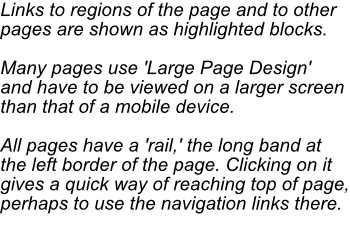
Introduction
Contrasts between poems and within the poem
A discussion, with digressions
Examples of composite poetry
Contrasts
between poems and within the poem
The
contrast between inter-contrasts ('between contrasts') and intra-contrasts
('within contrasts.') Anyone who ate one meal made up entirely of crisp, cold
food and another meal of soft, hot food would have contrasts of texture and
temperature, but obviously, the contrasts within one meal are what makes for
interest in eating. A poet's work may show strong contrasts between different
poems but contrasts within any poem are a separate matter. On this page, I
discuss contrasts within the poem.
Lack
of contrast in a single poem is no objection: a single poem which is tragic,
in free verse, and another which is light-hearted and rhymed, can each be
a very satisfying whole, but a contemporary poet should not always aim to
produce 'a satisfying whole.' The contemporary poet can attempt the unified
poem which contains within itself extreme contrasts. Baroque restlessness,
antithesis, dissonance - these and other effects give alternatives to the
'consistent' poem. Structural contrasts within a poem can playful, or virtuosic,
representing a hard-won victory over technical challenges, but should never
be simply an empty exercise in technique. Structural contrasts within a poem
can be the direct result of an urgent vision, such as a dissonant - and dissident
- vision.
Examples
of composite poetry
In
the first poem, a section in rhymed verse and partly in dialect (this is the
insert) is admitted as a block into a poem (the main text) which is in free
verse and standard English.
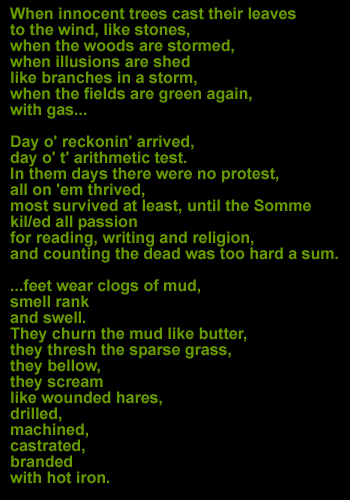
35
s (This is the timing
for
the poem.)
In
the next poem, the insert is different in tone and grammatical construction,
using interrogatives and no participles, unlike the main text:
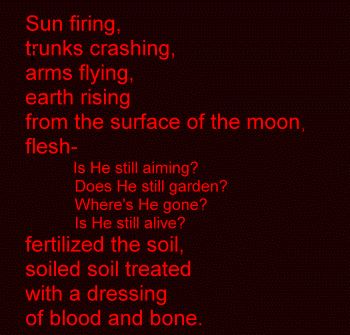
25s
In
interline poetry, the lines of the main text are double spaced
or more than double spaced and the insert, the contrasting material, is admitted
into the spaces between the lines. In the poem of mine below, the insert is
shown as bold print. The insert makes the point that self-examination, private
and personal matters in general, are relevant to war and the causes of war.
The dictionary gives as a meaning for a 'interline,' transitive verb, 'to
write or print (matter) between the lines of (a text...) (Collins English
Dictionary.)
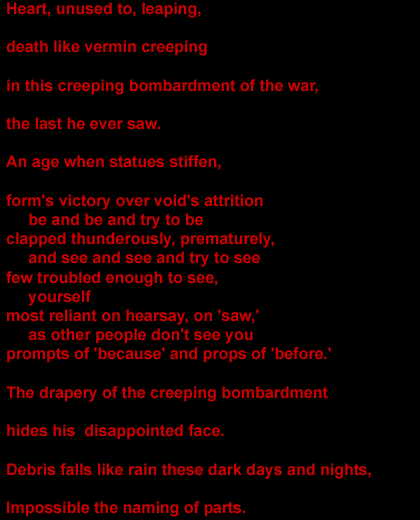
43s
'naming
of parts' refers, of course, to the body parts in the aftermath of the explosion
and refers also to the title of a poem I admire very much, the first poem
of Henry Reed's 'Lessons of the War.' 'Naming of Parts' is obviously a composite
poem. Each stanza has an insert. The insert in the first stanza is 'Japonica/Glistens
like coral in all of the neighbouring gardens':
Today
we have naming of parts. Yesterday,
We had daily cleaning. And tomorrow morning,
We shall have what to do after firing. But today,
Today we have naming of parts. Japonica
Glistens like coral in all of the neighbouring gardens,
And today we have naming of parts.
Two
more interline poem:
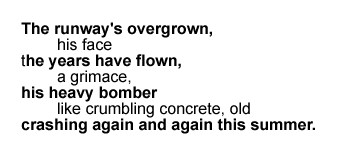
12s
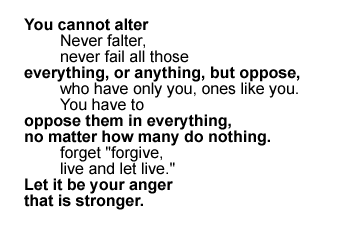
20s
Introduction
This
section is 'loosely systematic' and far from being purely systematic. There
are also digressions, linked with the matter in hand, taking in, for example,
the theatricality of the architect Vanbrugh and the architecture of Palladio.
Elements
are the entities which are linked and contrasted. The poetry which
contains linked and contrasted elements is composite poetry. Elements can
differ in these and other ways:
Formal
organization, strict or free
A poet who is using a rhythmical (not necessarily rhymed) and highly ordered
form can admit into the poem an element which is much more free - even prose
- with contrast and tension between the two modes.
There are various possibilities.
A highly organized poem may admit an element which is more free.
A poem which is free may admit an element which is more highly organized.
If the contrasting element is substantial, it may be admitted (a) as a block
(b) between the lines.
Very
strong contrasts and discords, which reflect our discordant age, can be achieved
by bringing highly organized and very free elements into collision. The contrast
may be great but not substantial. For example, a poem which begins in a completely
regular metre, setting up a regular pulse, may later have a spondee instead
of the expected dactyl in one place.
Subject
to change or not
The insert may be contrasted with the main text or the framework in being
temporary and subject to change. This is one possible convention:
The main text or framework is
(a) permanent or long-lasting, in the sense that the text does not change:
it will not necessarily be 'of permanent literary value.' It is not revised
later: it exists in a definitive version
(b) the work of the original poet.
The insert is
(a) to be regarded as subject to revision and temporary, unless its qualities
seem indisputable: in this case, it may be the insert which lasts, and the
main text or framework which withers away.
(b) the work of the original poet or a collaborator, although it may be replaced
by an insert which is either the work of the original poet or another writer
and so
The
contrast here between the permanent and the changeable will become more marked
with time. As the language changes, the main text or framework stays the same
(although it will be read differently) and the inserts will show to a greater
or lesser extent the impact of new forms of language, as well as new ideas.
The
contrast between the long-lasting and the temporary reflects the linkage between
buildings and the people who use them. A building could be described as a
'framework' but it would be demeaning to describe the people who use it as
'the insert.' Within this linkage, there is contrast between the building
- not permanent, but often lasting for many centuries - and the people, whose
existence is, unfortunately, of a strictly temporary kind.
Another
example of linkage between contrasting elements, one usually more long-lasting
than the other, is the linkage between house and garden, or between great
house and great garden: the linkage between building and garden design, or
between architecture and landscape design. As in the case of the composite
poem, the longer-lasting element here does not necessarily have artistic priority.
It is possible for a house which is mediocre to be surrounded by gardens which
are the work of a designer of genius.
Vanbrugh
was 'the first to appreciate the relationship of a building to the landscape;
more precisely, its picturesque qualities...Vanbrugh's approach had a strong
theatrical element, and scenic effects and attempts to convey a mood in landscape
design were later taken up more swiftly than in architecture.' (Jennifer Sherwood,
'The Buildings of England: Oxfordshire.') The linkage between these elements
in England took a very different form from that on the Continent:
The visitor from continental Europe, accustomed to the sight of Versailles,
Belvedere or Schonbrunn, finds this antithesis between architectural reason
(the palace) and natural unreason (the gardens) as as delightful as it is
unusual and illogical. To English philosophy and artistic theory, however,
there was no contradiction there, far more a perfect accord. Palladio's architecture,
on which the neo-classical style was based, was rational, functional and hence
'natural': in other words, as far removed as possible from French and baroque
building. The equation of nature and reason was extended to garden design.
This illustrates the fact that contrasts may be apparent rather than real.
Artistic
success
The main text and insert may be written at about the same time, in a collaborative
effort between two writers. This collaborative effort between the two may
be harmonious and fulfilling, but in essence, the project is difficult. This
kind of composite poetry is intensely demanding. The two are exposed to the
withering force of inevitable comparisons. It may be that the insert is clearly
banal or pointless compared with the main text, or the main text may be pretentious,
the insert may have profound quality. Alternatively, the difference in artistic
qualities may be far less pronounced, the comparative estimations may well
be reversed eventually, and the two may have distinct strengths to set besides
weaknesses, but the difficulties remain.
Generally,
if there is a difference in levels of seriousness, the main text will often
be more serious than the insert. An insert may take the form of a witty, light-hearted
contribution which is not intended to be a substantial contribution to art.
Genre
Composite poetry contains contrasts. I discuss 'concrete poetry' and concrete
poetry, particularly important instances of composite poetry, on the page
concrete.
Not
all poetry-image composite form is concrete. Instead of incorporating pictorial
material into the poem, it may simply be used to illustrate poetry, in a similar
way to its use in the illustrated novel. Dickens was exceptionally careful
in his supervision of his illustrators, and a poet who produces an illustrated
book of poetry will need to give great thought to the images, although the
collaboration between poet and illustrator may well be a partnership of equals.
Apollinaire's
book of poems Le Bestiaire, ou Cortege d' Orphee, published in 1911 and illustrated
by Raoul Dufy is one example of an illustrated poetry book. Picasso was to
have supplied the pictures, but produced only two engravings, and in the event,
they were not used.
Regionality
Region
poetry is different from the established form of regional poetry,
for example the poetry of the English regions or Jared Carter's poetry concerned
with Indiana. Regions
are
contrasted areas within a poem.
Function
Contrast
of function. The insert may have a great variety of functions. It may offer
a kind of commentary, it may give an opposing view, it may be more candid,
elevated, chaotic or scathing than the main text or the framework. It may
even act as a contemporary equivalent of the chorus in Greek tragedy. H D
F Kitto writes that 'The function of the chorus, as a lyrical body, was...to
amplify the emotional range of the drama...the chorus could, so to speak,
enlarge the area of reference: it could bring to the surface any philosophic
or dramatic implications of the action which might be hidden from the actors
themselves - in this way doing what minor characters often do in Shakespeare.'
Languages
This is not at all common. The anonymous lyric of the fifteenth century 'In
dulci jubilo' is not great poetry (although the original melody and the arrangement
by R.L. Pearsall are great music) but it integrates Latin and upper German
dialect very successfully:
In dulci jubilo
Nun singet und seid froh!
Unsers Herzens Wonne
Leit in praesepio,
Leuchtet vor die Sonne
Matris in gremio.
Alpha es et O.
A form which was used
in Provence, the 'descort,' has stanzas which are similar in structure but
in different languages, giving discord.
Degree
- marked or subtle
Zoned poetry
is a form where the differences
between elements are subtle. This form arises naturally from the fact that
in a poem which has lines of appreciable length and which has an appreciable
number of lines, the first line and the last line will tend to be more prominent
than the intervening lines, and the beginning and end of each line will often
tend to be more prominent than the middle of each line. Such a poem will have
a border made up of the first and last lines and the beginnings and ends of
lines. This is the border region, and the rest of the poem is the interior.
Zoning in a poem reflects the principle that when a work
of art is of significant extent, we cannot attend to all parts of it equally,
at the same time. Position in the poem gives natural emphasis to the border
region, but the poet may counterbalance this prominence by drawing attention
to the interior, using highly stressed syllables, vivid expression, colour
and other devices.
Zoning
is valuable in giving a more pronounced structure to free verse. It also gives
a new way of reading some of the poetry of the past. Section 36 of Whitman's
'Song of Myself' provides an instructive example. This begins:
Stretch'd and still lies
the midnight,
Two great hulls motionless on the breast of darkness,
Our vessel riddled and slowly sinking, preparations to pass to
the one we have conquer'd,
The captain on the quarter-deck coldly giving his orders through
a countenance white as a sheet...
and ends with the line:
These so, these irretrievable.
This
section can be read in such a way as to increase subtly, almost imperceptibly,
the exterior of the poem: the first and last lines, the beginnings of the
lines (Stretch'd, Two great hulls, Our vessel, The captain...) and the ends
of the lines (the midnight, darkness, conquer'd, white as a sheet...)
As
a conscious technique which can be used in writing a poem, zoning provides
new possibilities of contrast. The poet and the reader will also be sensitive
to the significant change in the proportion of interior to exterior in turning
from a poem of few, short lines to a poem of many, long lines.




